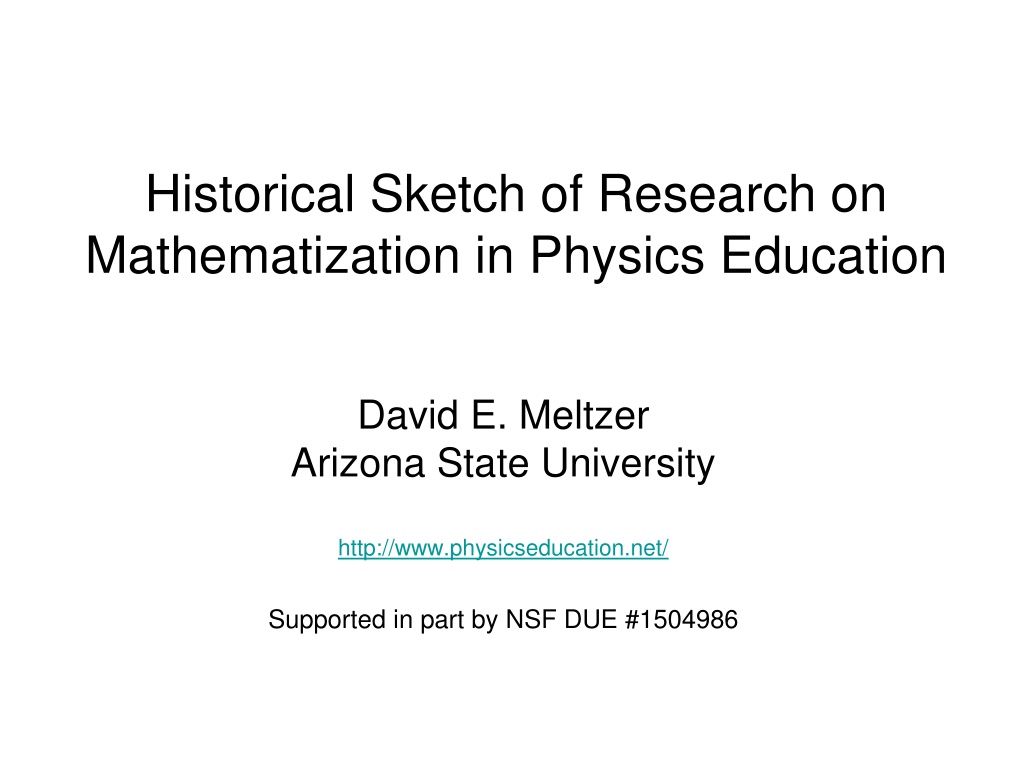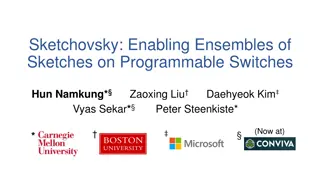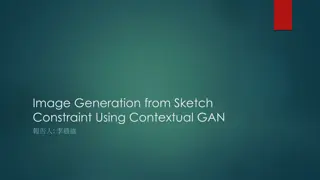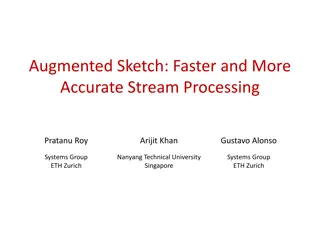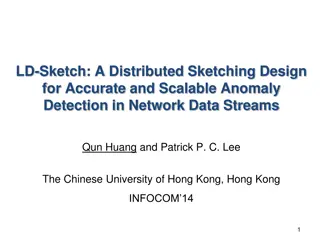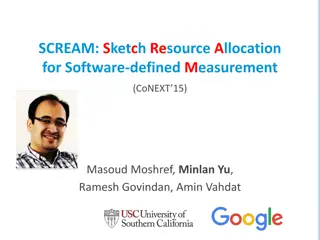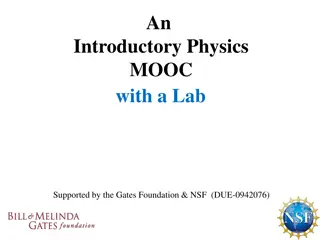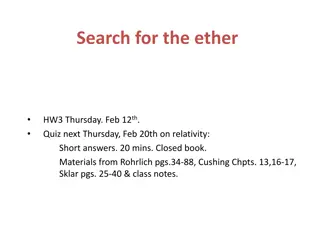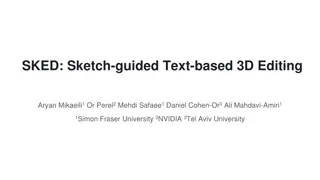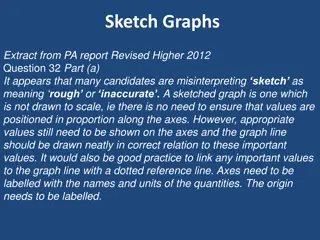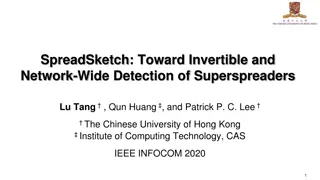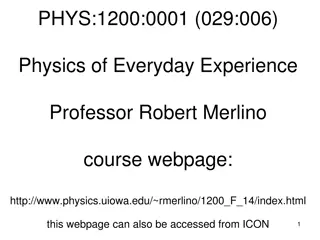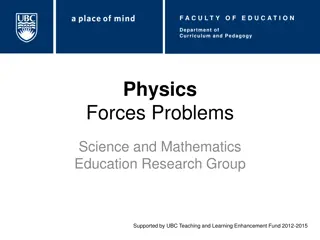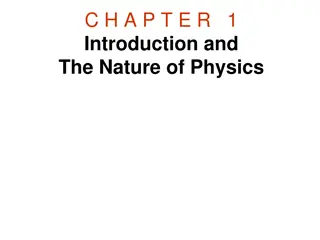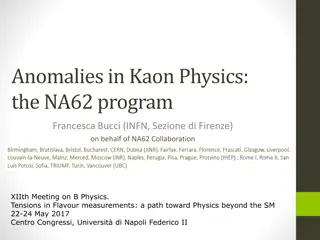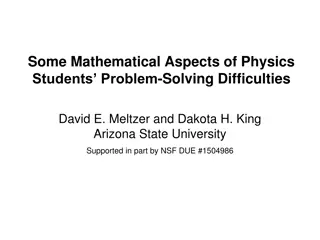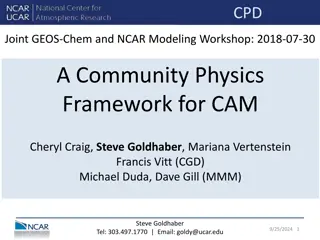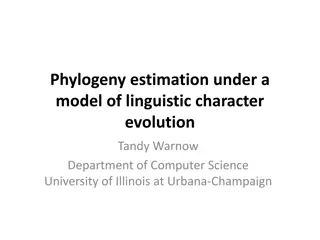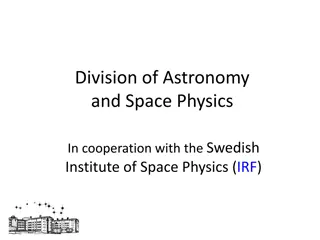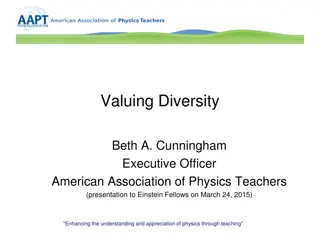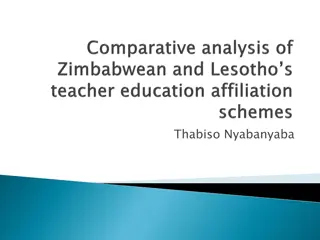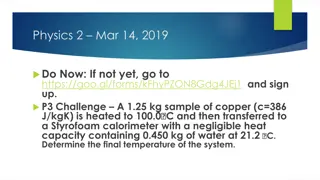Historical Sketch of Mathematization in Physics Education: Evolution and Challenges
The historical progression of mathematization in physics education from high school to college level is explored, tracing back to the early 1900s. The shift towards quantitative measurement and mathematical problem-solving in high school physics instruction led to debates over de-mathematization, impacting student preparation for college physics. Investigations revealed deficiencies in students' math skills, prompting ongoing studies and the quest for better alignment between mathematical preparation and physics education.
Download Presentation

Please find below an Image/Link to download the presentation.
The content on the website is provided AS IS for your information and personal use only. It may not be sold, licensed, or shared on other websites without obtaining consent from the author. Download presentation by click this link. If you encounter any issues during the download, it is possible that the publisher has removed the file from their server.
E N D
Presentation Transcript
Historical Sketch of Research on Mathematization in Physics Education David E. Meltzer Arizona State University http://www.physicseducation.net/ Supported in part by NSF DUE #1504986
Development of Students Mathematical Thinking Most college physics students receive their initial mathematical preparation in middle school and high school The mathematical landscape of physics students thinking must be traced back to these formative years
The High School-College Connection Until the 1870s, high school physics instruction was largely qualitative, light on math As high schools spread and enrollment increased, they became increasingly important sources for college admissions High school physics instruction began to resemble college more closely: emphasis on quantitative measurement and mathematical problem solving
The Teacher Preparation Dilemma Very weak high school physics teacher education in the early 1900s contributed to ineffective preparation of students for college physics College entrance exam scores were low, and high school instructors began to rebel at the heavy influence of the colleges A new movement of physics teachers attempted to re-focus high school instruction on inductive, lab-centered learning
De-Mathematization and Backlash Some suggested de-mathematization of high school physics: Prof. A. A. Michelson (1909) A backlash developed as some investigators tried to show that de-mathematization was leading to poor learning.
Studies of Physics Students Math Skills Beginning in 1918 and continuing today, investigators have probed physics students mathematics preparation and asked whether it s adequate for college physics. Many mathematics diagnostic tests have been administered to high school and college physics students. Almost always, students mathematics preparation has been found wanting.
Representative Results from Diagnostic Tests Randall, Chapman, and Sutton (1918) claimed poor performance showed that de-mathematization was damaging physics students ability to have thorough understanding and exact thinking. Hughes (1924) argued to the contrary, that poor math performance by university students showed that it was not possible to mathematize high school physics to any great extent and still get satisfactory achievement. Lohr (1925) concluded that it was necessary for university physics teachers to re-teach until [they are] sure of assimilation of the mathematics involved before attempting to give the physics using these principles. Kilzer (1929)concluded that there was a need for maintenance drills covering the math needed in high school physics courses. Breitenberger (1992) found that new physics graduate students were deficient in math skills and mathematical thinking!
Probes of Maths Impact on Physics Performance Bless (1932) found a very high correlation between university students physics grades and their scores on an arithmetic/algebra diagnostic test. Carter (1932) found a similarly high correlation among high school students. However, he noted that the correlation was sharply reduced when student s intelligence (determined by an IQ test) was held constant Kruglak and Keller (1950) found a high correlation between math course grades and physics course grades of university students.
Additional Analogous Results Based on Grades or Diagnostic Test Scores, by: Blumenthal (1961) Bolte (1966) Larkin and Brackett (1974) Hudson and McIntire (1977) Cohen, Hillman, and Agne (1978) Champagne, Klopfer, and Anderson (1980) Hudson and Rottmann (1981) Champagne and Klopfer (1982) Hudson and Liberman (1982) Wollman and Lawrenz (1984) Griffith (1985) Halloun and Hestenes (1985) Hudson (1986) McCammon, Golden, and Wuensch (1988) Linder and Hudson (1989) Hart and Cottle (1993) Alters (1995) Sadler and Tai (2001)
But the Problem is More Complicated Weak calculational skills are only part of the problem. Many early studies were flawed by conflating difficulties with physics concepts together with weak mathematical skills, and presuming the combination was problems with math. Undeveloped technology limited the tools available for visualization of functional relationships, as well as real- time interaction with the outcomes of calculations. (Those of us who went to college in the late 1960s-early 1970s did most of our calculations for course exams on a slide rule!) Up until the 1970s, there was virtually no research on which to base efforts to improve the situation.
Glimpses of the Future Lapp (1940) showed that university students who were taught to give a qualitative analysis of a physics problem that is, describing in words exactly how they could go about solving it had substantially higher scores on a standard physics diagnostic test compared to students who were taught merely to find quantitative solutions to the same problems. Black (1931) carried out a rare investigation of physics students thinking in a physics context, using written diagnostics and one-on-one student interviews
Interlude Lots of research by physicists during the 1960s and 1970s on students mathematical and scientific reasoning processes (Robert Karplus et al.) However, not directly in the context of physics Research on general problem solving, carried out in a physics context (Fred Reif et al.) Not directly linked to studies of mathematization Direct precursor to future investigations by many PER workers focused on methods of physics problem solving Workshop on Physics Teaching and the Development of Reasoning by Karplus et al. (1975), and The Various Language by Arons (1977) both contributed greatly to future advances in research-based curriculum development
McDermott and the PEG Lillian McDermott and the University of Washington Physics Education Group (PEG) demonstrated that physics students mathematical skills, physics ideas, and reasoning abilities are not easily disentangled, and must often be studied together, in the context of authentic physical systems. The PEG investigated students abilities to work with multiple representations of physics ideas, including graphs and diagrams.
Some Examples Probing students thinking regarding ratios of differences, e.g. v/ t Trowbridge and McDermott, 1981 Investigating students ideas about graphical representations of motion McDermott, Rosenquist, and Van Zee, 1987 Examining the utility of computer simulations to probe student thinking McDermott, 1990; Grayson and McDermott, 1996
Further Work In the mid-1980s, David Trowbridge developed some of the very first physics simulation software ( Graphs and Tracks ) based on his Ph.D. research directed by McDermott. Beginning in 1986, Thornton, Sokoloff, and Laws utilized the PEG s research to help develop curriculum based on real-time data acquisition and visualization using probeware and computers (computer graphing the microcomputer-based labs, or MBL ) Thornton (1987); Laws (1989); Thornton and Sokoloff (1990) Beichner (1994) made use of PEG work in developing his diagnostic test on kinematics graphs.
Redish and the Maryland PER Group From early on, Joe Redish emphasized that efficient accessing of ideas could be as important as forming them in the first place: -- Redish (1994)
Mental Models for Mathematization The further work of the Maryland group explored the mental models that influence students learning and use of mathematics for physics: -- Redish (1994)
Later Work by the Maryland Group Students often fail to make use of specific mathematical tools that they do know how to use, because they don t recognize their applicability to a physics problem Bing and Redish, 2009; Gupta and Elby, 2011
Summary Despite nearly a century of efforts, research on mathematization in physics education tended to circle around and repeat similar studies with few new insights through the 1950s Work by physicists Arons, Karplus, and Reif during the 1960s and 1970s had an enormous impact and helped set the stage for modern PER McDermott, Redish, and their students and collaborators, helped catalyze critical breakthroughs that continue to guide much of the work done today.
